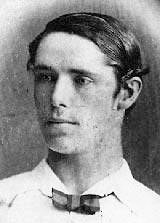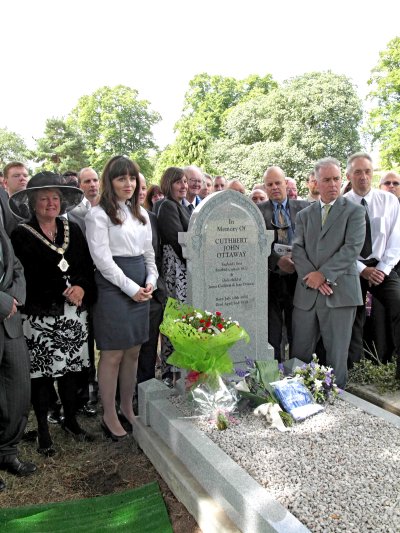West Hampstead’s astonishing football pedigree

As the World Cup kicks off a continent away, we cast our eyes back to Victorian times – and the little-known fact that West Hampstead and Kilburn played an important role in the Football Association and early football.
There are three parts to this story: Arthur Pember, was the FA’s very first Chairman back in 1863. He lived in Carlton Road, later called Carlton Vale, and he established a team called No Names Kilburn.
Cuthbert Ottaway was the first captain of the England football team and is buried in Paddington Cemetery, off Willesden Lane. And finally, West Hampstead Football Club, which was banned from joining the FA and once had a Scottish “ringers” on its books.
Arthur Pember was born into a wealthy family in 1835 at 4 New Park Road off Brixton Hill. In 1848 the family moved to Clapham Park where Arthur was educated by a governess with his four sisters and his brother George. Arthur became a stock broker and joined his father at Jones Loyd and Co. Arthur was very energetic and as a keen mountaineer, he climbed Mont Blanc and later wrote and lectured about the ascent.

Arthur Pember and His Incredible Moustache
On 13 March 1860, at St Mark’s Church on Hamilton Terrace in St John’s Wood, he married Elizabeth Hoghton, the daughter of a fellow stockbroker who lived at 7 Abbey Road. After their marriage they moved to 26 Carlton Road, Kilburn (later renamed Carlton Vale), close to Elizabeth’s parents. Sadly, following a miscarriage, Elizabeth died in December 1860. Arthur was devastated and moved to 30 Carlton Road where he lived alone apart from three servants. He married his second wife in 1862. Seventeen-year-old Alice Mary Grieve was the daughter of William Royal Grieve, a wealthy wine merchant who lived at 3 Waterloo Cottages on the Kilburn High Road. They had four sons.
About 1863, Arthur formed the No Names Club of Kilburn. The unusual moniker may have been a play on words based on Arthur’s stockbroking background where investors were typically known as “Names”. The team played on fields opposite his home in Carlton Road. These fields later became Paddington Recreation Ground. NN (Kilburn) appears to have continued until 1870. Apart from Pember, the only other NN players we know are CM Tebbut, Lawson and A. Baker.
Football, in various forms, had been played for many years, but there was no agreed version of the rules. In October 1863, a letter in The Times sparked a debate about establishing a universal code. Further letters followed from several public schools, such Eton, Harrow and Rugby, but with no enthusiasm for a single version of the rules.
The first meeting of the Football Association was held at the Freemason’s Tavern, Great Queen’s Street, on the 26 October. Arthur Pember, from No Names Kilburn, was the chairman, and the secretary was Ebenezer Morley from the Barnes club. A series of further meetings were held in November and December 1863. Although the public schools were invited, they didn’t attend. There was considerable debate, with the main point of discussion focussing on whether the ball could be carried or not. Pember and Morley pushed ahead despite opposition from Rugby and other public schools, to say that under the FA rules players could not carry the ball and that hacking and tripping was not allowed. This effectively distinguished football from rugby.
In September 1864, there were 18 teams in the FA, including No Names Kilburn. Very few sides outside London used the FA rules for several years. In 1866 NN Kilburn complained that there were so few clubs adhering to the new code that they were able to play matches only against Crystal Palace and Barnes that year. Arthur Pember was the FA chairman until 1867 when Morley took over.
In 1868 Pember decided to take his family to New York where he worked as a journalist. To obtain material he worked in disguise in the poorer parts of the city. He looked at prostitution and gambling and in 1874 wrote a book about his ‘undercover sleuthing’ adventures. He died in 1886 in North Dakota.
Cuthbert Ottaway was born in Dover in July 1850, the only child of James Ottaway, a surgeon and former mayor of the town. Cuthbert had a privileged upbringing and was educated at Eton and Brasenose College Oxford. He was a very talented all-round sportsman who represented Eton in racquets and in their annual cricket match against Harrow. At Oxford he became the only student who was awarded Blues for football, cricket, racquets, athletics, and real tennis. After Oxford he practiced as a barrister. He played cricket for the Gentleman against the Players and opened the batting with W.G. Grace on many occasions.

Cuthbert Ottaway, England’s first football captain
Although playing several sports at a very high level, Ottaway gained most fame as a footballer. He led the England team against Scotland in what is now recognised as the first international football match on 30 November 1872. He was again captain in the England vs. Scotland match in 1874. Like many others in the early days of amateur sport, he played for several teams, and took part in three successive FA Cup finals between 1873 and 1875. He was a centre forward and particularly noted for his speed and skill at dribbling.
In 1872 during an England cricket tour of Canada he met and fell in love with 13-year-old Marion Stinson. She was sent to England to finish her education and when she was 17 they were married in Ottawa. They returned to London and lived at 34 Westbourne Place, Eaton Square. But less than a year later, in April 1878, Cuthbert died aged only 27 while Marion was pregnant. The cause of his death is not clear. It was said that he caught a chill after a night’s dancing and died from complications. But diabetes ran in his family and this may have contributed to his susceptibility to respiratory diseases. It is also possible that he had earlier contracted TB. When he died his personal estate was less than £800, worth about £64,000 today.
A memorial for him was erected at Paddington Cemetery in August 2013. The grave is in Section 1F, grave number 5628. There is a website for more information at http://cuthbertottaway.blogspot.co.uk.

Ottaway memorial celebration at Paddington Cemetery (Simon Inglis, August 2013)
The first record of West Hampstead Football Club is an 1895 newspaper report when the team was due to play Wood Green. In 1897, West Hampstead FC joined the Second Division of the London League alongside Fulham and Orient and that season they finished fifth out of ten clubs. The following year, after promotion to the First London Division, they finished eighth of the nine clubs. In 1900/01 they won the Middlesex Cup beating London Caledonians.
The following season – 1901/02 – the team joined the superior Southern League Division Two, and finished fifth out of nine teams. The division included Fulham (the current club), Shepherds Bush, Brighton and Hove Albion, and Wycombe Wanderers.
Problems arose during the 1902 season when Shepherds Bush FC complained about West Hampstead FC. This was a time when there was considerable disagreement betweem those ‘gentlemen’ with sufficient income to play as amateurs and working class players who wanted to be paid.
The FA held a commission of inquiry in January 1903 which concluded that Mr J.C. Christie, Sec. and Treasurer of West Hampstead FC, did not provide the commission with evidence or hand over the books relating to the management of the club, although repeatedly being asked to do so. Because of this he violated the rules of the FA and would not not admitted to membership of the FA, nor to take part in their football or football management until further order.
Five members of the club’s committee were suspended until the end of the 1903/4 season. One of these men, Joseph Comodonico, was a blacksmith who lived in Agamemnon Road and who later worked for the Hampstead Council. The club captain, a W. Denham, was declared a professional and was suspended for one month
Perhaps most bizarrely, the FA said, “The fact of bringing in players under the names of Gray, Craig, Barber, and Reid (whose proper names are believed to be respectively: Graham, Adams, McDonald, and Nesbitt), from Scotland, will be reported to the Scottish FA.” In other words, the club had brought in four ‘ringers’ from Scotland who they paid to play for West Hampstead.
Even though the FA had legalised professionalism as far back as 1885, the London FA was one of the last county associations to deny membership to professional clubs. In 1907 this issue caused a split when they broke away from the FA to form the Amateur Football Association. The AFA continued until 1914 when it rejoined the FA.

West Hampstead FC in 1903
The photograph shows the team as the winners of the Middlesex Cup and the Hospital Charity Shield, 1902-3. We know that some of team members were the four Westley brothers, who are probably some of the men with moustaches in the photo. These were, Harold Charles Percy Westerly, outside left, Arthur John West Westley, fullback, Francis Joseph Westley, goalkeeper, and Herbert Oscar Westley, no position given. They were the sons of John Westley, of Lee in Kent. He was a cashier to a foreign banker. None of the brothers seem to have lived in West Hampstead. There were six Westley brothers in all, who signed up together for the Boer War. One brother, Gerald was killed.
The man holding the ball is the captain Herbert Kingaby, who was born in August 1880 in London. Kingaby initially worked for a woollen manufacturer. After he played part-time for Clapton Orient he was sold to Aston Villa for £300 in March 1906. Here he was paid the football maximum wage of £4 per week but after two months, Villa were not impressed with his ability. They were unwilling to lose their £300 with a free transfer, so offered to sell him back at half price but there were no takers. His wages were stopped and he was placed on Villa’s retained list which effectively stopped him earning a living in the English League, so he joined Fulham in the Southern League. At the start of the 1910/11 season he re-joined Clapton Orient. That year the FA and the Southern League agreed to mutual recognition of each other’s retain and transfer systems. Villa now disclosed that Kingaby was still on their retained list and demanded £350. This prevented a move to Croydon Common but he eventually joined Peterborough City in 1910 for one season.
In March 1912 Kingaby brought legal proceedings against Villa for preventing him from playing. The Player’s Union funded his legal costs, but his counsel concentrated on Villa’s use of the transfer scheme and made no use of the law on restrictive practices. The suit was dismissed and the Union were almost financially ruined. Kingaby played with Croydon Common from 1913 to 1916, when he seems to have ended his career. He died in 1957 in London.
Wondering where the football ground was? We’re not sure exactly. In October 1896, Hampstead Council agreed to write a letter to the secretary of West Hampstead FC complaining about the excessive noise from supporters at their matches on land near Hampstead Cemetery. This interfered with services taking place at the Cemetery on Saturday afternoons. So at this time they clearly played close to the Cemetery. The Victoria County History says that West Hampstead Football Club had a new ground at Willesden Green in 1898. We haven’t been able to find where this was. A football ground is shown off Cricklewood Lane on the 1912 Ordinance Survey map.
We would like to thank Dil Porter, De Montfort University Leicester, and West Hampstead resident Simon Inglis, the editor of the Played in Britain series, for their help with this story.


